
The AYANEO SLIDE was provided by AYANEO for review. Thank you!
If there is one thing AYANEO is consistent with, it is creating new handhelds that try to innovate somehow. From the AIR 1S, which is a powerful device with an OLED screen that fits perfectly in your pocket, to the KUN, an oversized powerhouse with a large battery and dual trackpads, the company has tried to break the mold and give users different options to fulfill their handheld needs. They have been focusing on a new retro aesthetic, seen most recently in their Mini PC line, but this also comes over to handhelds, and it starts with the AYANEO SLIDE.

Reminiscent of sliding phones from years ago, the AYANEO SLIDE‘s standout feature is the sliding screen that can reveal a full keyboard underneath. This device came around the same time as the only other sliding device I have, the GPD WIN 4, so this was one of my first experiences with a device like this completely, as I never had a sliding phone. And now, after using it, I may not be able to return to a keyboard-less handheld so easily.
As always, before I start talking about my experience with the device, I want to review the specs and different models available and the model I was sent for this review. First, in each device, you can expect these internals:
On top of that, each device has hall effect joysticks and triggers, an X-axis Linear Motor for vibration, a six-axis gyroscope, a 3+2 triple copper tube cooling system, and a full-functioning QWERTY keyboard with RGB lighting effects. There are also three ports on the device:
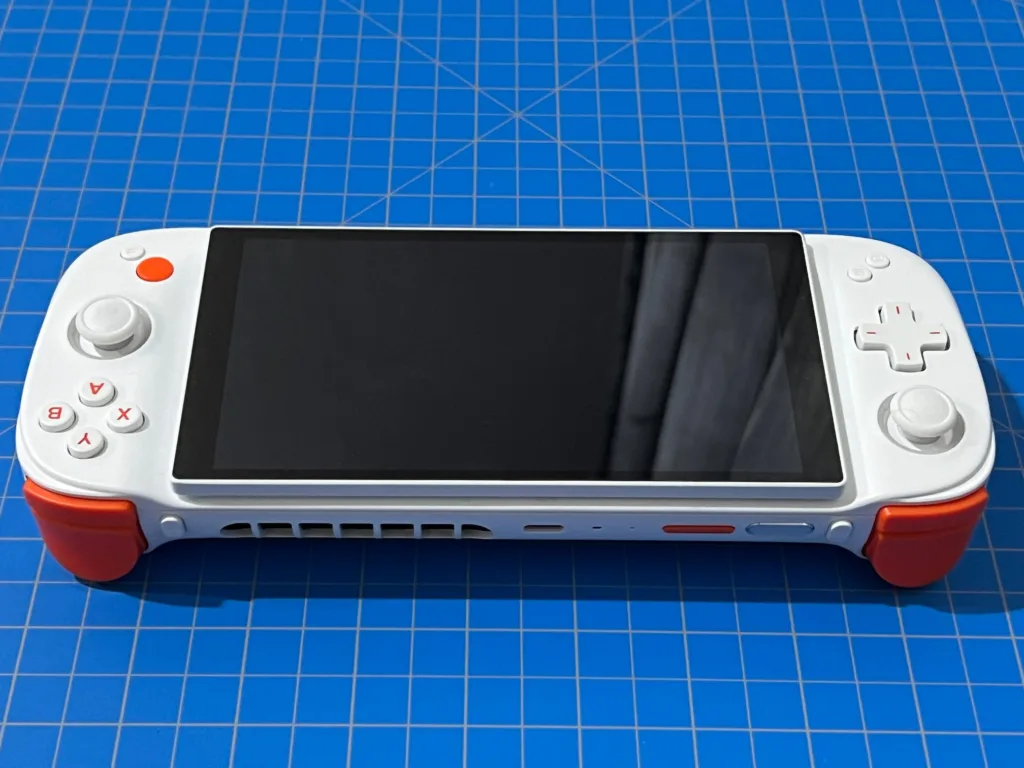
Then, we have the different models available. There are four models of the AYANEO SLIDE available with each one having a different RAM+storage space configuration:
While I would consider the 64 GB RAM model to be a bit too expensive, I would consider the other models much more affordable, especially the lowest-priced version. With a $700 price tag and similar specs to the ROG Ally, this seems like a very competitive alternative for those wanting something more unique than an average handheld.
AYANEO sent over a 32gb RAM + 2tb SSD version of the device to review, so that’s what I am basing my write up on. Now, let’s get to the review!
First, let’s talk about the design. I am a big fan of the AYANEO SLIDE‘s slightly smaller and more compact size. I can confirm that, because it is a bit smaller than the average-sized handheld (7-inch screens), it can fit in my pocket more easily and is wonderful to carry around. Even though it is a bit smaller, the handles come out just enough to where it is comfortable to wrap my hands around it. The Dpad and ABXY buttons feel fantastic, and while the joysticks are a little on the small side, they work well and are hall effect, so almost no deadzone and risk of drifting. For the small frame, it does feel a little heavy to hold at times, but it was never too much.
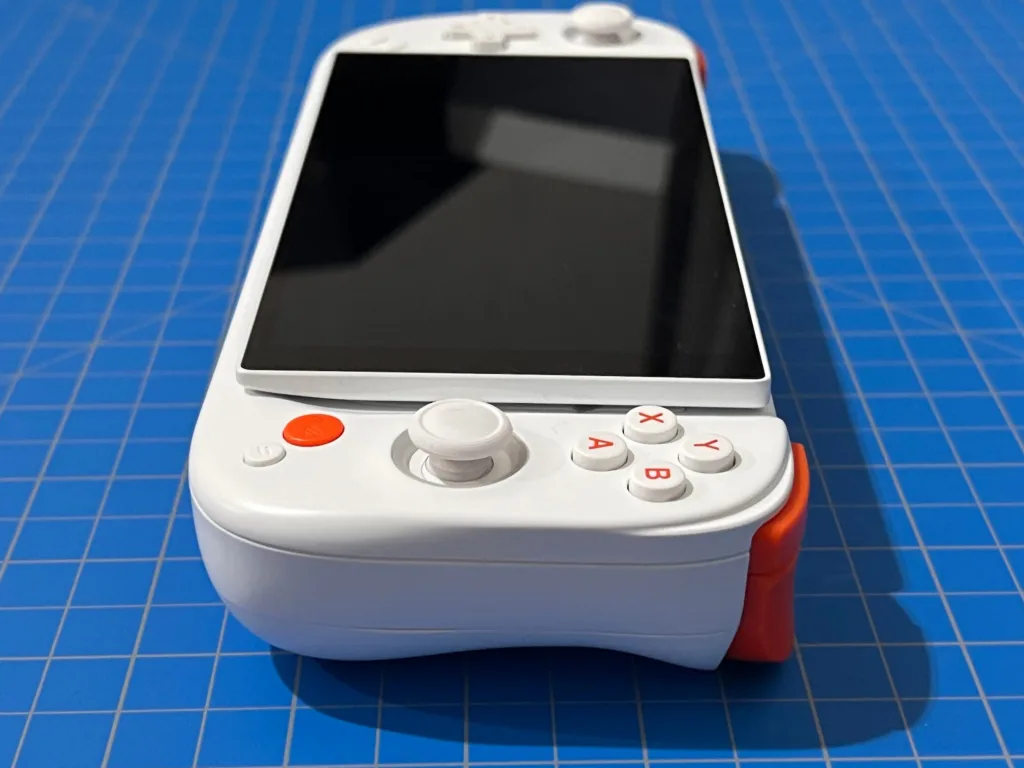
I also really like the shoulder buttons. They feel great to push down, and the small buttons next to them, which can be programmed with different functions, are well-placed and easy to reach. The triggers work well, too, but I prefer them to feel like they have a little resistance. The SLIDE‘s triggers feel like they have almost no resistance at all and are extremely easy to push down. Some people will like it, and they do the job. I just prefer it to feel a little harder to push down.
Probably the biggest design flaw that I can think of is the lack of a 3.5mm audio jack. Yes, a lot of people are using wireless or Bluetooth headphones that will be able to connect to the SLIDE, but it still feels like a weird oversight. I am much more willing to part ways with the audio jack over something like the MicroSD card slot, like in the NEXT LITE, but it just feels weird to have it missing. Other than that, both USB-C ports are USB4, which is fantastic for data transfer and to use with an eGPU like the G1 from GPD or OneXGPU from OneXPlayer.
Now, we have the standout feature of the AYANEO SLIDE, the actual screen. The screen itself is quite wonderful. For an LCD screen, the colors still pop quite nicely, and it feels very sharp due to the 1080p resolution. This resolution also means the entire screen will be covered if we have to go down to 720p resolution for harder-to-run games and it will cover the entire screen. It is also a touchscreen, so you can interact with it while covering the keyboard or when slid up.

Speaking of sliding, it is a spring-loaded screen, so all you have to do is slide it up about 30% of the way, and the springs will handle the rest with a nice clicking sound. Moving the screen up and down feels extremely satisfying thanks to this clicking sound, which happens when you move it up or move it back down. It can also be angled by about 30 degrees, so you don’t have to bend your head down as much when using it. The keyboard is also a little on the bigger side, and for my fat fingers, this is much appreciated. The RGB backlighting is quite nice as well!

Unfortunately, because the screen can be angled, it is lifted up from the rest of the device. This means that when it is slid up, the screen does wobble a little bit. The wobbling is more noticeable when the screen is angled, but it does wobble a little bit when not angled. If you play without moving too much, you won’t be plagued by this, but if you move, you will feel it.
This is where I feel the AYANEO SLIDE really shines. Like other handhelds using Windows OS, it is hard to use and navigate with a handheld. For the easiest and most comfortable navigation, you must use the touchscreen to type things in, which is a bit of a chore. Some devices, like the Steam Deck and ONE-NETBOOK devices, have a virtual keyboard that the gamepad can control, but it is slow and can be annoying to use. That is not an issue with the SLIDE.
Thanks to the full keyboard underneath the screen, typing things in and searching is significantly faster and overall easier. And because the keyboard is a bit on the larger side, it is very easy to hit each button with my fat fingers. It is a little too big to use my thumbs to reach the entire keyboard without adjusting my hands, but my hands are stubby, so I wasn’t expecting it to be perfect. The keyboard has saved a ton of time and spoiled me enough to the point that I now find it hard to use Windows on a handheld without this keyboard. You can use the joysticks and ABXY buttons to emulate the mouse, but it moves a bit slow, and I ended up using a combination of the touchscreen and keyboard.
There is also a thumbprint sensor on the power button, which is so nice, and it makes unlocking the device easy. For whatever reason, I could never set it up correctly on the other handhelds I have with it, but with the SLIDE, I did, and it is fantastic.
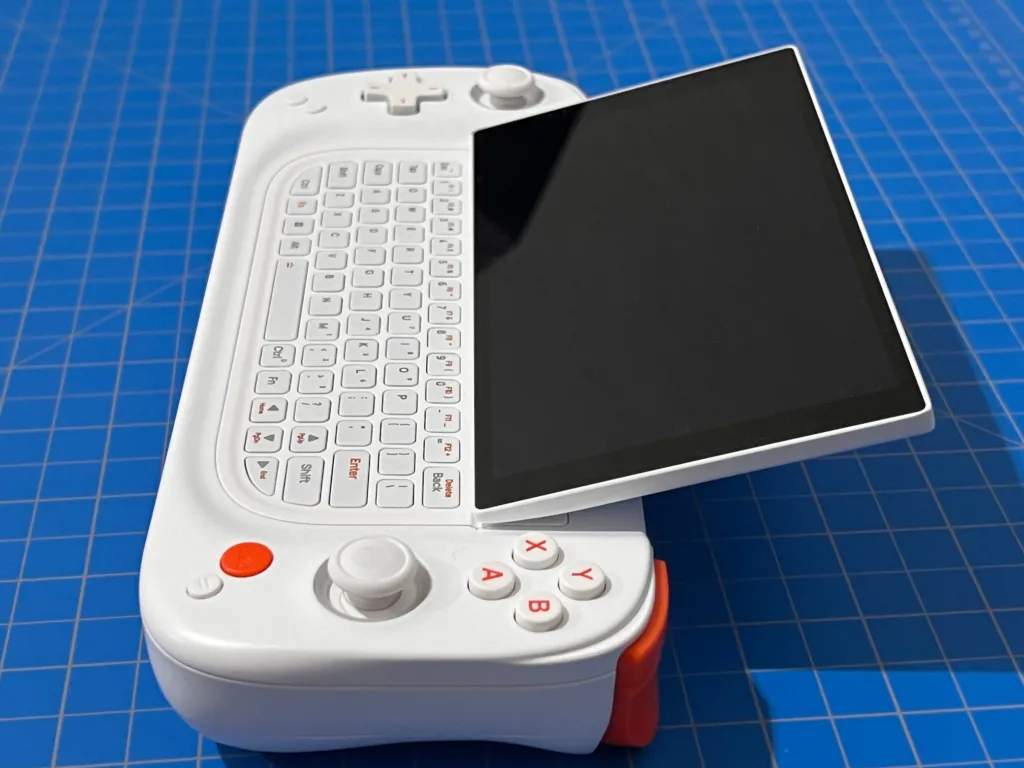
Otherwise, it is a standard Windows experience and can be used as a normal computer. Office work will be extremely easy to do thanks to the keyboard, and you can use heavier productivity programs like Photoshop. I would plug it into a monitor with a full keyboard and mouse for the heavier programs, and I wouldn’t do much video rendering, but it can be pushed for most uses. It can be a good portable desktop computer if necessary.
You also have AYASpace here, one of my favorite quick access/management applications for handhelds. It has a lot of handy tools perfect for handhelds, including FPS limits, TDP changes, and even changing the backlit keyboard’s color. There is a lot that AYASpace can do and optimize for different games, as well as the actual hardware, and I can’t recommend using it enough.
Now, let’s get to the performance and what it’s like to play games on the AYANEO SLIDE. I did hear some instances of games not working due to the keyboard input messing with the gamepad in some games, and I did encounter it once with Prey. It is possible there may be some games like this that won’t recognize the gamepad due to the attached keyboard, but I didn’t encounter any. The SLIDE also has a max TDP limit of 28W, so it can be pushed quite far for the most part.

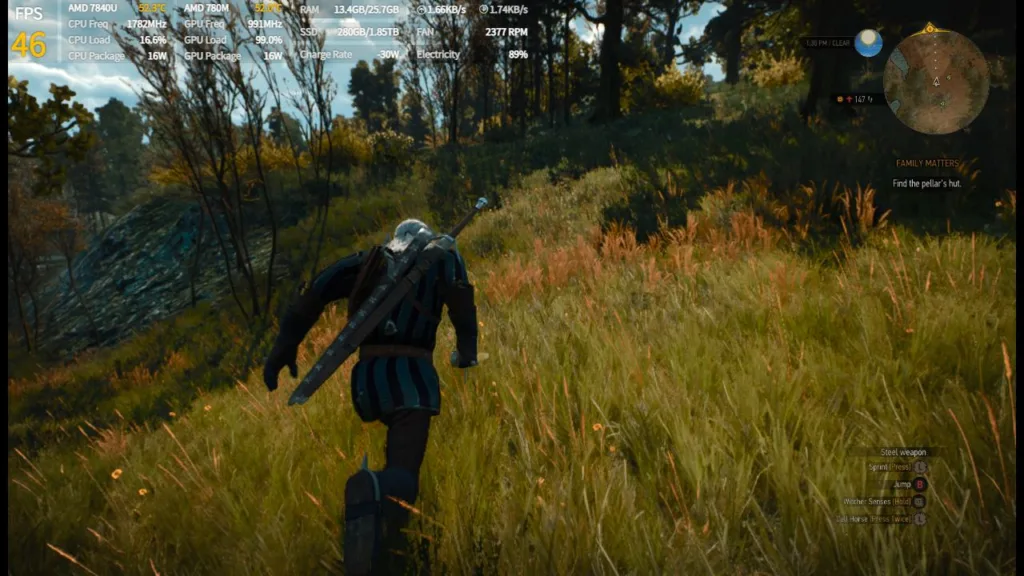


This was actually one of the games I heard had issues with the keyboard interfering with the gamepad, but I didn’t have it here. On default settings, I was able to use a 16W TDP for 1080p 30 FPS gaming, and it looked phenomenal. Dropping it to 720p with the same settings can bring the framerate up to around 45-50, but I would cap at 40 for a stable rate.
Cyberpunk 2077 on the SLIDE generally has the same performance other 7840U devices do. It is able to get 30 FPS on low settings at 1080p, or 40 FPS at medium settings with a 720p resolution and FSR 2.1. Overall, it feels great on the device and can get around 2 hours of gameplay.


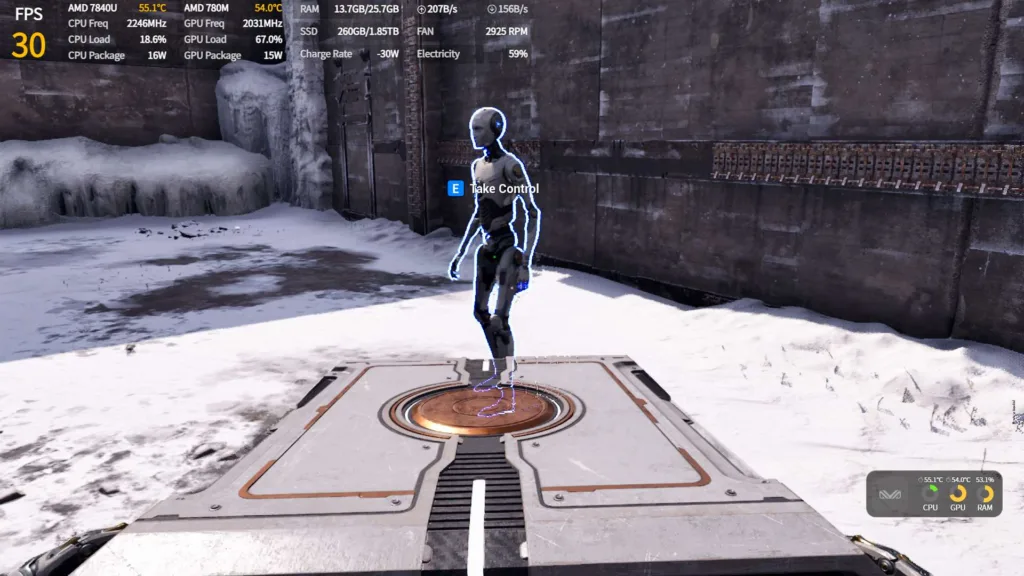
The Talos Principle 2 is a tough game to run on handhelds, but it is very playable on the SLIDE. At 16W TDP, we can get a solid 30 FPS at the default settings, which are almost the lowest. With this in mind, I would recommend playing this way for a little over 2.5 hours of battery, but if you want to push it to no limits and lower the upscaling, you may be able to get to 40 FPS.
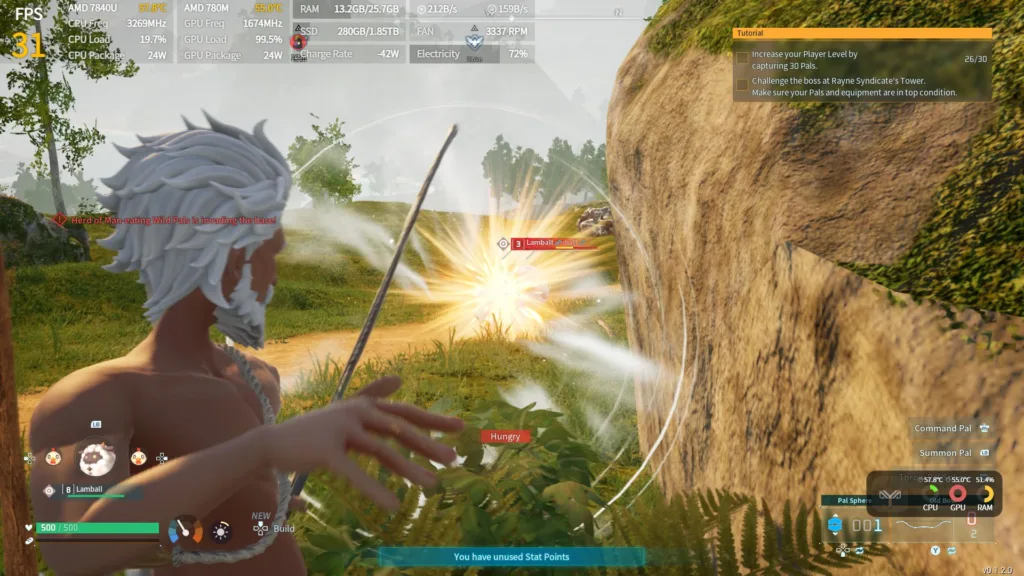

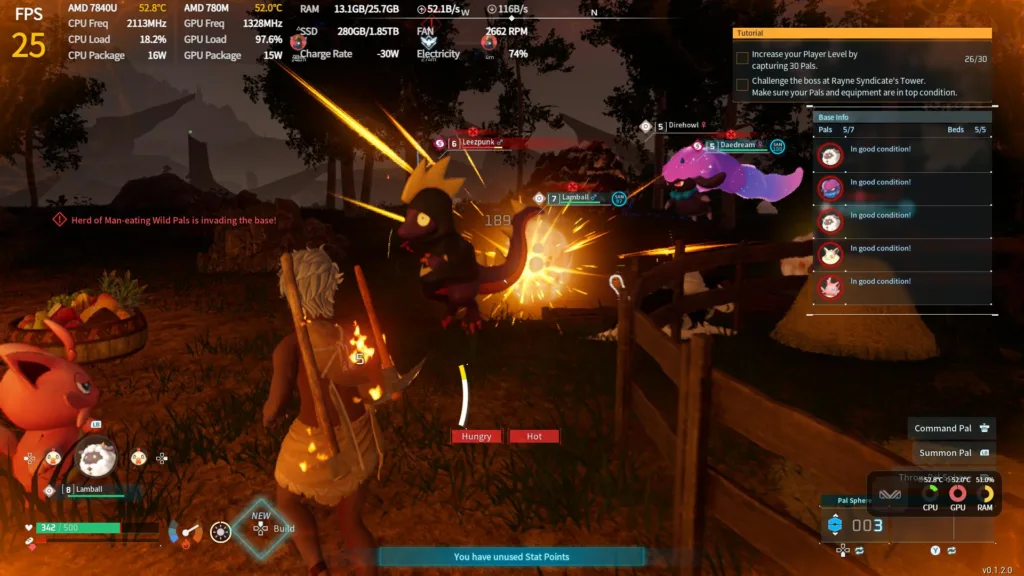
Palworld is an early-access game, so it hasn’t been fully optimized yet, but it is playable on the AYANEO SLIDE. I did have to set the TDP to 24W and graphics to medium, so it is a bit on the higher side, but it is playable at 30 FPS in denser areas and can hit 40-50 in more open ones. It was only able to be played at 1080p, as 720p would be windowed, but if this changes later, it should be much more playable.

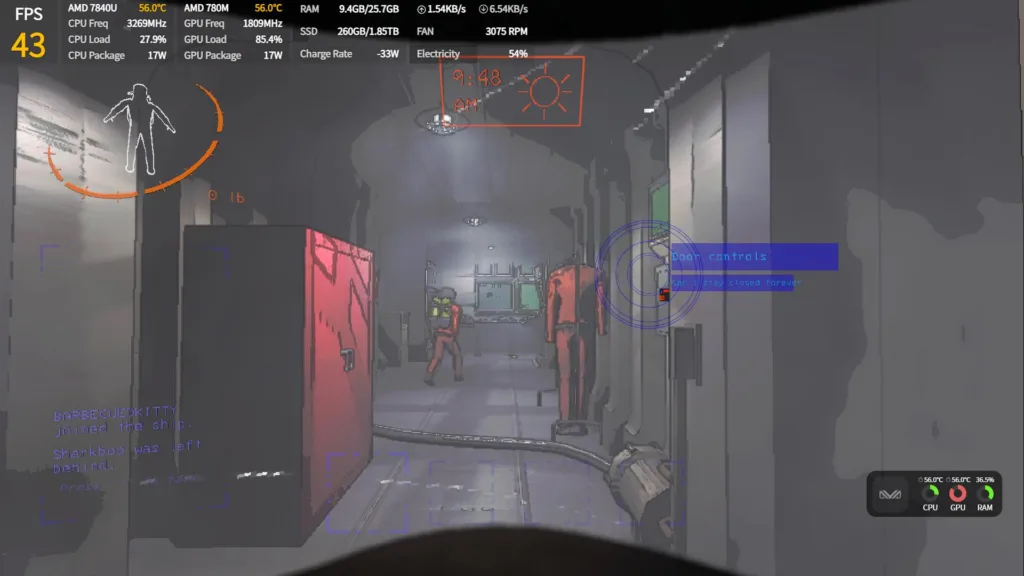

This is probably one of the best ways to play Lethal Company on a handheld. Because the terminal requires typing in, the keyboard attached to the SLIDE is perfect for it. As for performance, it runs at around 40 – 45 FPS when in some outside worlds at 18W TDP, while inside buildings, it can hit 60 FPS at 15W. This ends up being around 2 – 2.5 hours of battery life in this case, and I think it is a perfect balance since the inside is where the majority of attacks happen.
Stardew Valley is an extremely easy game to run, which is generally how I test the maximum battery life you could get while gaming. With a TDP limit of 6W, I was able to get around 4.5 hours of battery, which I found wonderful. The colorful screen makes it pop, too, which I very much enjoyed.
When playing a heavy game for a long period of time, probably around an hour to an hour and a half, I noticed the handles on the SLIDE get quite hot. It’s not enough to burn or make you take your hands off, but it’s definitely noticeable and slightly uncomfortable. I did try turning on the fan to max, and it did help, but the device was vibrating a little bit too much for my liking, so I ended up turning it off.
This could be an issue with my device, as I have seen others who mention the cooling system isn’t bad, but for me, I can absolutely feel the heat. It could also be my hands, as I know they generate heat and can get hot too. For what it’s worth, the back of the device didn’t get that hot, and it mostly congregated around the handles.
As for the speakers, they do the job, but they can sound a little bit muffled from time to time. It works well, and I had no issues with it, but it did feel a bit muffled in Cyberpunk 2077 and Death Must Die.
The AYANEO SLIDE is a device I could see becoming my main Windows device. I love the form factor and the keyboard underneath the screen makes navigating the desktop so much easier. Pair it with AYASpace to manage the system and the 7840U APU, we have so much to love in a small package. It does feel a bit weird that there’s no 3.5mm audio jack, the screen wiggles a bit when slid out, and my device does get hot, but I will still be using the SLIDE a lot! Even with the faults, I enjoy the device, and I would still consider it a solid deal for its price.
The AYANEO SLIDE can be purchased right now on Indiegogo.
If you enjoyed this review, check out the rest of the content on HandheldHQ! We have a wide variety of reviews and news that are sure to help your gaming experience. Whether you’re looking for news and handheld reviews, or just want to stay up-to-date on the latest trends, we’ve got your back.


Does it run SteamOS?
It ships with Windows 11. To my knowledge, AYANEO don’t support installing HoloISO on it.
SteamOS itself is currently only on the Steam Deck, and Valve haven’t allowed other handhelds to use it.